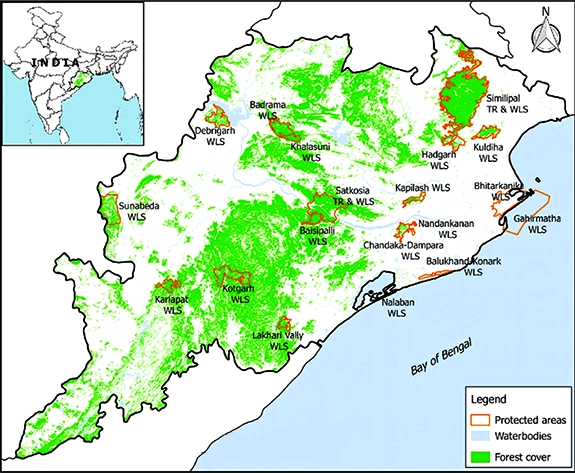Description

Disclaimer: Copyright infringement not intended.
Context
- Melanistic tigers have been recorded only in the Similipal Tiger Reserve in Odisha.
- As per the 2022 cycle of the All India Tiger Estimation, 16 individuals were recorded at Similipal Tiger Reserve, out of which 10 were melanistic.
About Similipala Tiger Reserve
- The name Similipal comes from the "Simul" (silk cotton) tree.
- It was formally designated a tiger reserve in 1956 and brought under Project Tiger in the year 1973.
- The Indian government designated it as a biosphere reserve in June 1994.
- Since 2009, it has been a member of the UNESCO World Network of Biosphere Reserves.
- It is a part of the Mayurbhanj Elephant Reserve, also known as the Similipal-Kuldiha-Hadgarh Elephant Reserve.
- This reserve consists of three protected areas: the Kuldiha Wildlife Sanctuary, the Hadagarh Wildlife Sanctuary, and the Similipal Tiger Reserve.
- Location: It's in the Mayurbhanj district of Odisha, towards the north. It is located at the easternmost point of the eastern ghat.
- Coverage: The biosphere, which occupies 4,374 sq km, is made up of 1,400 sq km of transition space, 2,129 sq km of buffer land, and 845 sq km of core forest (tiger reserve).
- Vegetation: There are 96 species of orchids and 1,076 blooming plant species in Simipal.
- It boasts expansive meadows, high level sal woods, dry deciduous hill forests, tropical moist deciduous forests, and tropical semi-evergreen forests.
- Wildlife: In addition to 304 species of birds, 20 species of amphibians, and 62 species of reptiles, Simipal is home to a diverse array of wild animals, including tigers and elephants.
- Tribes: The Erenga Kharias and the Mankidias are two tribes that live in the reserve's woodlands and engage in customary agricultural practices, such as gathering wood and seeds.
- Forest Fire Vulnerability:
- Natural: There are occasions when forest fires here are caused by natural factors like lightning or even extremely high temperatures.
- Man-made factors: Include hunting and poaching incidents when the poachers light a small area of forest on fire to distract the wild animals, which can result in forest fires.

Other Major Protected Areas in Odisha
- National Parks:
- Bhitarkanika National Park: It is home to the largest congregation of the endangered SaltWater Crocodile in the country.
- Wildlife Sanctuaries (WLS):
- Badrama WLS: It is characterized by the presence of Moist Sal Forests.
- Chilika (Nalaban island) WLS: Asia's largest and world's second-largest lagoon. Recently, direct sightings of school of Irrawaddy dolphins have been reported here.
- Hadgarh WLS: Salandi river passes through it which is home to mugger crocodiles.
- Baisipalli WLS: It is a sal dominated forest with a significant number of tigers, leopards, elephants, herbivores like Chousingha.
- Kotagarh WLS: It consists of dense deciduous forests with grasslands.
- Nandankanan WLS: First in the world to breed White tiger and Melanistic tiger.
- Lakhari Valley WLS: It is a dwelling place of a large number of elephants.
- Gahirmatha (Marine) WLS: It is a mass nesting spot in Indian Ocean region and the only turtle sanctuary in Odisha.
- The Olive Ridley turtles travel across the South Pacific to breed on the coast of Gahirmatha.
|
PRACTICE QUESTION
Discuss the critical role played by biosphere reserves in addressing and mitigating the challenges posed by climate change.
|











